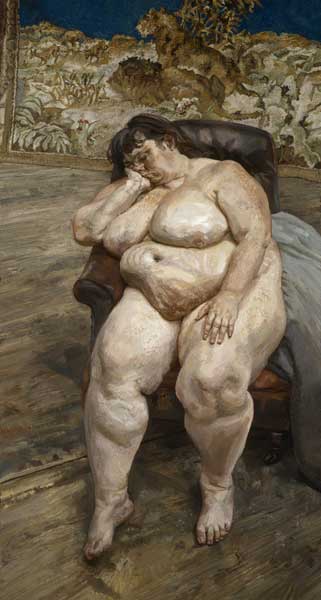Great Works: Sleeping by the Lion Carpet 1995-6 (228.6cm x 121.3cm), Lucian Freud
Lucian Freud Archive, Lewis Collection

Even at the very beginning of his long career as a painter of the human figure, Lucian Freud, who died last week, displayed the characteristic features of his looking. He was an obsessive, from beginning to end, and in his earliest works he was principally interested in eviscerating – yes, that's exactly what it felt like - two kinds of subject matter, the human physiognomy and still life. The way he treated a still life was rather similar to the way he treated the human face. It was a matter of comparing one kind of object with another kind of object. Each was a thing under intense scrutiny, to be dismembered as if it were a watch to be taken apart and then re-assembled.
The intensity of his stare at the human face seemed to be matched by the reciprocal stares of his sitters. There was seldom anything affable about Freud's painterly engagements. No one smiled. It was a question of holding one's own against brutal, singular acts of extended enquiry. The eyes of the sitters sometimes bulged ferociously – Freud's own eyes bulged in a similar way in a late photograph of him taken in his London garden. Sometimes the painted eye could appear so full and so heavy that it almost seemed to fall out of its socket.
Freud always strove to be as minutely – and as tightly – descriptive as possible. The hair was painted stroke by stroke – at times, early on, the careful modelling of the hair rather resembled Beardsley's fin de siècle mannerisms. The subject felt caged, pinioned, wrung dry. Freud always pounced upon elements of irregularity – one ear larger or smaller than another, for example. The lighting was often stark – there was no risk that Freud was ever likely to lapse into the easy flattery of a Van Dyck. He was never inclined to raise up his subjects for our extended delectation. It was their materiality, their singular earthiness, that always counted.
How alive did these sitters seem to be? In some of his earliest drawings, the face is shown in conjunction with some element of still life – the prone head of a flower, for example, in Woman with a Tulip (1945), for example. The flower and the woman's head seem to have the same emotional weight. They are being observed for the various ways in which they seem to resemble each other – does the colour of the lips match the colour of the petals? Yes, somewhat. The whole scene has a kind of savage plasticity about it.
The choice of subject matter for the early still lives inclined towards the savage too: a prickly gorse bush; the ferociously rebarbative thistle; the chicken thrust into a bucket; and, among the very best of all, the magnificently splayed carcass of a Dead Heron of 1945, one of the most celebrated of his early works, in which Freud seems so beguiled by the patterning and the colour range of the feathers – and by that ferociously pointed beak. Freud clearly absorbed myriad influences in those days – his earliest included the brutally chilling hyper-realism of Otto Dix in particular, and the neue sachlichkeit painters in general. This pitched him from time to time in the direction of caricature.
As Freud moved into the 1950s, more colour and more fluidity in the rendering of the flesh began to appear. A wonderful breakthrough towards something more engagingly human had happened in 1948, when he did a magnificent portrait in black and white conté crayon of the hedonistically fleshy face of Christian Berard, lying back, showing the super-abundant fullness of the flesh of the cheek. At last, Freud seemed to have stopped observing detail for its own sake. He gave us what he was later to give us in such abundance: a piece of fully rounded characterisation. By 1957, when he painted Man in a Mackintosh, his later manner was in full evidence – the variegated colours of the flesh of the face are puddling and merging. Freud was still looking as hard as ever, but he was also learning to let go and allow himself to be seduced by the wonders of human flesh for its own sake.
Then, in the 1990s, when Freud was already in his seventh decade, came the marvellous physical force and presence of Sue Tilley, the benefits supervisor. Tilley was made for Freud and his palette. It was as if he was now sculpting in two dimensions. In this painting, which shocks us by its sheer superabundance, the great overpouring of her flesh puts mere lions in the shade. How can the king of the jungle even begin to compare, asks this portrait of the sleeping Tilley with a lion carpet reared up in the studio behind her, with this magnificent specimen of superabundant fleshiness? Freud has done his utmost to emphasise the spillage, the sloppage if you like. It is too small a place for her, this chair. She overwhelms it. She crushes it. There is wave upon wave of her. It never stops coming at us, foldings and heavings of flesh rendered in a multiplicity of tones, from a delicate pink at the knee and down the lower legs to the freckly browns and yellows at her shoulder. Freud wants this cheek crushed and skewed back into the face like this, pushing her chin askew. He wants her massy presence crushed into itself in this way. He wants the weight and the alarming, unstoppable heft of her measured by every stroke of the febrile brush.
Join our commenting forum
Join thought-provoking conversations, follow other Independent readers and see their replies
Comments